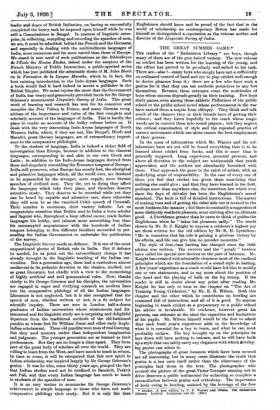THE LANGUAGES OF INDIA.* LET us seize the opportunity afforded
to us by the advent of this massive tome to congratulate Sir George Grierson, the • Linguistic Survey of India. Vol. VIII.. part I.: Indo-Aryan Family, North- Western Group. Specimens of sandhi and Landhl. Compiled and edited by Sir G. A. Grierson, P.BA.. etc. Calcutta : Superintendent of Govern- ment Printing. (7 Ea., 8 annas.1 leader and doyen of British ladianists, on having so successfully completed the heavy task he imposed upon himself while he was still a. Commissioner in Bengal. In matters of linguistic enter- prise, in_collecting, compiling and recording the speeches of men, we are, it must be admitted, behind the French and the Germans, and especially in dealing with the multitudinous languages of India, more numerous and far more varied than those of Europe. We stand in sore need of such publioatione as the Bibtiothegue is rEcole des Hautes Etudes, issued under the auspices of the French Ministry of Public Instruction, a public-spirited series which has just published the admirable thesis of M. Jules Bloch on is Formation de Its Langue ifaratke, which is, in fact, the best existing introduction to the Indo-Aryan languages. Such a book would find it hard indeed to secure a publisher in the British Empire. We must rejoice the more that the Government of India has wisely and generously provided funds for Sir George Grierson's monumental Linguistic Survey of India. This great work of learning and research has won for its conceiver and compiler the Prix Volney in France, and many German recog- nitions, of the importance and value of the first complete and scholarly account of the languages of India. This is hardly the place to render an account of the bulky volume before us. It deals with the very interesting Indo-Aryan languages of North Western India, which, if they are not, like Bengali, Hindi and Marathi, great literary languages, are of extraordinary import- ance to the comparative philologist.
To the student of language, India is indeed a richer field of investigation than Europe, because in addition to the classical languages, corresponding to and akin to our own Greek and Latin ; in addition to the Indo-Aryan languages derived from these and singularly resembling the Romance tongues of Europe ; India still preserves, what Europe has mostly lost, the aboriginal and primitive languages which, all the world over, are destined to be superseded by the stronger, more supple, more literate speeches of civilised men. They die, yet in dying they affect the languages which take their place, and therefore deserve attentive study. They deserve to be recorded while yet they can be heard by capable and attentive ears, since otherwise they will soon be as the vanished Celtic speech of Cornwall. Their number is enormous, their variety infinite. Let us congratulate ourselves that Dublin sent to India a born scholar and linguist who, throughout a busy official career, made Indian languages his hobby, and (almost more astonishing feat than his unexampled acquaintance with the hundreds of Indian tongues belonging to five different families) succeeded in per- suading the Indian Government to undertake the publication of the survey.
The Linguistic Survey needs no defence. It is one of the most unquestioned glories of British rule in India. But if defence be needed, let us point out the extraordinary change it has already wrought in the linguistic teaching of the Indian uni- versities. Not a generation ago, these had a curriculum almost mediaeval in its pedantic devotion to the classics, studied, not as great literature, but chiefly with a view to the memorising of highly artificial and arid grammatical rules. Now, thanks chiefly to Sir George Grierson and his disciples, the universities are engaged in eager and vivifying research on modern lines into the comparative philology of all the Indian languages. Literature is not neglected, but it is also recognised that the speech of men, whether written or not, is a fit subject for scientific inquiry. There are now in London half-a-dozen graduates of Indian universities whose attainments and dis- interested zeal for linguistic study are a surprising and delightful departure from the traditional methods of the old-fashioned pundits at whose feet Sir William Jones and other early Anglo- Indian scholars sat. These old pundits were men of real learning. But they used memory rather than independent imagination and judgment. The younger generation are as learned as their predecessors. But they are no longer a class apart. They form part of the great body of scholars all over the world. They are willing to learn from the West, and have much to teach in return.. In time to come, it will be 'recognised that this new spirit in Indian scholarship was inspired largely by Sir George Grierson's genius. It was ha who, some thirty years ago, grasped the fact that Indian studies need not be confined to Sanskrit, Prakrit and Pali, and that every Indian language has much to teach to students of the speeches of men.
It is no easy matter to summarise Sir George Grierson's achievement in simple language to those who have not made comparative philology their study. But it is only fair that Englishmen should know and be proud of the fact that in the world of scholarship no contemporary Briton has made for himself so distinguished a reputation as the veteran author and director of the Linguistic Survey of India.











































 Previous page
Previous page